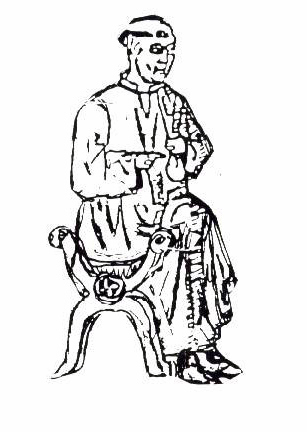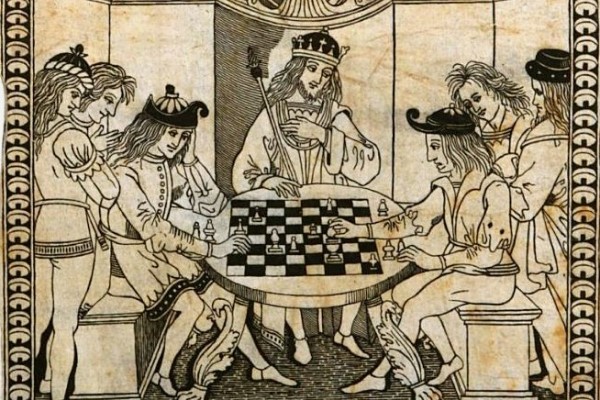Part 2: Outlining the rules of the game
This is the second of a three-part series. Part 1 was an introduction; in Part 3 we will dig deeper into the poem's historical relevance.
The poem exhibits several precise elements that connect it with the chess universe:
1. It consists of sixty-four chained verses (which follow the ABAB /BAB/CC metric rhyme), the same number of squares on a chess board.
2. The story begins thus, giving the poem its name: "Trobant se Març ab Venus en un temple, / ensemps tenint Marcuri (en) sa presencia, / ordi hun joch de scachs, ab nou exemple: (…)"
As Mars met Venus in a temple,
While having Mercury in their presence,
He devised a game of chess, with new example:
The expression "with new example" is key, as it gives a clear indication that this is the modern form of the game and, in that sense — adding the details that we will mention below — the poem can be considered to be a work that outlines the rules of chess.
3. It is noteworthy that colouring the squares is presented as a novelty. And in fact it was! In the Eastern versions, the squares were single-coloured — they were usually white. In the poem:

Mercury, always ready in his ways,
Painted the board with hues clear and dark:
And made it Time, split into days and nights,
A box to bring the first enclosures.
4. The idea of the squares being associated with time ("pintà•l 'taulell de sorts clares y escures" and "partis per nits y diez", in the original), is in line with the famous quatrains of the Persian Omar Khayyám (1048-1131), who wrote in his Rubáiyát: “
But helpless Pieces of the Game He plays
Upon this Chequer-board of Nights and Days;
[Translation by Edward FitzGerald (5th edition, 1889)]. Jorge Luis Borges (1899-1986) invokes the work of the Persian in one of his sonnets:
The player also is a prisoner
(The saying is Omar's) of another board
Of black nights and of white days.
[Image: Narcis de Vinyoles]
5. Each piece is given specific characteristics. Red pieces were described thus:
Taking Reason as King without preeminence;
Will for Queen, with great potency;
Thoughts he deems for his Bishops;
His Knights, praises of sweet eloquence;
Rooks are desires to flare up one’s memory;
Pawns are servers striving to Victory.
Bishops, who are associated with Thoughts, were usually representations of wise, old men, who gave advice to the monarch.
6. Green pieces, on the other hand, were depicted as follows:
Desired for her Rooks cautious reserve;
For Knights, disdains of deserved return;
Her Bishops, glances of delightful sight;
For her Lady she took most pleasing beauty;
And her King, following the tale of love,
Was Honor, his life ever in danger;
For faithful Pawns he took courtesy,
All armed and clad with ostentation.
7. The queen's mobility is expanded "ab gran potencia" ("with great potency), as you can witness in the game presented below.
8. As we could imagine, fairly classical ideas of medieval moral values are followed. Reason and honour are attributed to the king; to the queen, the most feminine virtues of will and beauty; in the case of the rooks, the gift of desires contrasts with the representation of shame; a kind of contradiction occurs in the case of the knight, between praise and disdain; bishops are attributed, for both the red and green pieces, positive qualities: thoughts and delightful sight; while the humble pawns are relegated in the social hierarchy, as can be expected within the framework of the rigid courts, considering them as mere servants — although they seem to be vindicated by being associated with courtesy (which should, of course, be given to their masters) and by being given the chance to be promoted.
9. The knights are given a place of nobility, when the author says:

For a Knight, mostly one of noble breed,
Should not wish to stain an honest fame.
10. In addition to clarifying the way in which the pieces move, some regulations that continue to this day are mentioned, like the touch-move rule ("Diu que lo tocat se hagia de jugar").
The first rule you must abide by
Is, in this game, that a piece once touched
Firmly, admitting neither debate nor confront,
By any player, true, must be played.
The rule is then justified by making a parallelism with life itself:
It falls to reason: for a lover's thoughts
Having chosen, cannot freedom afford
Or doubt, but take full submission.
Thus the saying: “Courage and folly
In every move, as once done, done it is!”
[Image: Bernat Fenollar]
11. The game begins with the king's pawn moving two steps ahead:
He moved towards the field of the beautiful
The most valiant Pawn in conquest:
He moved two paces towards her.
By this move the King discovers Reason
And opens the road of Will.
So, while the monarch may become unprotected, the queen is allowed to show her strength, and the fight begins...
 This DVD is for anyone who knows the rules of chess but would like to be able to improve their game with some specific tactics and strategies. It builds on the basic principles of chess that should have already been learnt.
This DVD is for anyone who knows the rules of chess but would like to be able to improve their game with some specific tactics and strategies. It builds on the basic principles of chess that should have already been learnt.12. The previous mention clearly denotes that the game begins — according to the prevailing chess notation — with e4 (P4K, in descriptive notation). And so it will be from then on: each stanza is easily associated with a specific move, so we can follow the sequence of the game, in which the red pieces will end up clearly imposing their strength over their green counterparts.
13. Three paths to victory are mentioned. Some are not in use nowadays, as the "mat offegat" (stalemate), which later would not lead to defeat but to a draw, and the "mat robat", when the king is left alone, with no piece of his army left over the board (this is not enough to win a game in modern times). The prevalent "mat comú" is also mentioned, which happens when the king cannot move to any square and none of his pieces can help him (while being threatened at the same time, i.e. the classic checkmate).
14. Another rule that might seem strange to us, which the arbiter Fenollar points out, is that the empowered queen cannot capture her colleague and that catching her counterpart loses the game. It is prescribed that the queen must be at the service of the king since:
If Will won't placate Reason,
It stands to sense that the captured be felled.
15. As for the king, the so-called "leap of joy" is considered, as the following passage shows:
The next decree for this our game
Is that Kings to their third house,
At first shot, keeping within measure,
May jump in total freedom;
In an older form of chess, šatranj, the piece known as fers was allowed a similar jump — it could move three squares backwards when it was the product of a sarbaz (pawn) promotion.
 The purpose of this DVD is to teach players how to conduct the attack on the black king using different methods. Although the Italian Game and the Ruy Lopez are mostly positional openings, it is very often possible to make use of attacking methods of play
The purpose of this DVD is to teach players how to conduct the attack on the black king using different methods. Although the Italian Game and the Ruy Lopez are mostly positional openings, it is very often possible to make use of attacking methods of play16. In some medieval versions of chess — and despite the fact that when exposed it was in a very dangerous position — the king was given the ability to jump. Ruy López de Segura (c.1530-1590) mentioned this possibility in his Libro de la invención liberal y arte del juego del ajedrez, published in Alcalá de Henares in 1561: "…the first time you can jump three houses through the path you wish finding the path cleared; and this neither above a piece, or a pawn, own or else's, as long as it is not to capture the opposite: because the King cannot jump and seize..." [Own translation].
17. This "king's leap", in any case, can be considered to be a predecessor to castling. In this sense, this leap served as a model to the modern manoeuvre, since it can only take place under three conditions: a) that the king cannot capture any piece in the jump; b) that the king cannot jump over other pieces; and c) that the jump cannot be made when the king is in check.
18. As often happens, the intricacies of the game offer poets a chance to give lessons or moral advice, such as the following:
- The enterprising one, to get his way / will not be stopped by turns or thrusts.
- One who takes action must look, to learn, / to not being hit by the aims he's taken.
- So the one in love, when inflamed by passion, / should not attempt to damage the goods of honor; / and, if he dared do so, as she flees, his plan is broken.
- By its nature fire is always burning, / but water will make it dance back to measure.
- Thus showing the world that in meting punishment or revenge / they must blend mercy with wrath, / and not overflow their understanding; / for, if they are great with their wings of potency, / greater they’ll be by using clemency.
- Conformity is the most certain bet / as among lovers it feeds their friendship.
- For a discreet flight is better / than to fall prisoner because of rash concerns.
- ...disaster never follows / one who can sense the scent.
- We are all equal, in death and birth: / so equal musty our fearing be.
- The winner, in winning, watches his shot / for often the foe, in turning, overcomes.
- One who would force a victory will only find defeat.
...among others.
The game lasted 21 moves, with De Castellví checkmating Vinyoles while marshalling the red (white) pieces. The complete poem translated to English can be found here.
Translation from Spanish: Carlos Colodro
Links



















 For a Knight, mostly one of noble breed,
For a Knight, mostly one of noble breed,




